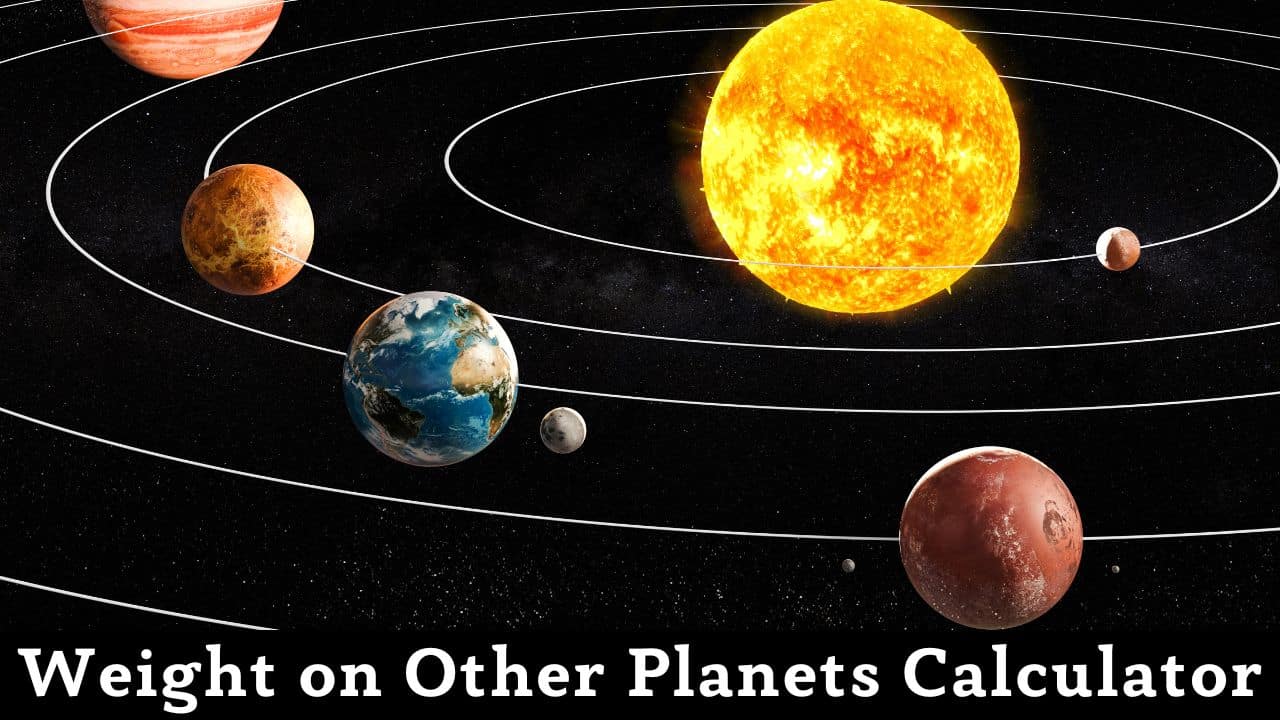
Understand Weight and Gravity Across the Solar System
Explore how gravity affects weight on different planets and learn the science behind planetary physics!
What is Weight and How Does it Differ from Mass?
Weight is the force exerted on an object due to gravity, while mass is the amount of matter in an object. This fundamental distinction is crucial for understanding how we weigh planets and why your weight changes on different celestial bodies while your mass remains constant.
Why weight varies across planets: Each planet has a different mass and radius, resulting in different surface gravity. The formula W = mg shows that weight (W) equals mass (m) times gravitational acceleration (g). Since your mass stays the same but gravity changes, your weight varies dramatically across the solar system.
Weight vs Mass Examples:
- On Earth: A 70 kg person weighs 686 N (154 lbs)
- On Moon: Same 70 kg person weighs only 114 N (26 lbs)
- On Jupiter: Same 70 kg person weighs 1,640 N (369 lbs)
- In Space: Same 70 kg person weighs 0 N but still has 70 kg mass
- Key Point: Mass never changes, only weight changes with gravity
Planetary Gravity and Surface Conditions
Surface gravity depends on a planet’s mass and radius according to the formula g = GM/r². This relationship explains why massive planets don’t always have the strongest surface gravity – it also depends on how far you are from the planet’s center.
Planetary Gravity Comparison:
| Planet/Moon | Surface Gravity (m/s²) | Gravity Relative to Earth | Weight Factor | Escape Velocity (km/s) |
|---|---|---|---|---|
| Mercury | 3.7 | 0.378 | 37.8% | 4.25 |
| Venus | 8.87 | 0.905 | 90.5% | 10.36 |
| Earth | 9.81 | 1.000 | 100% | 11.18 |
| Mars | 3.71 | 0.378 | 37.8% | 5.03 |
| Jupiter | 24.79 | 2.528 | 252.8% | 59.5 |
| Saturn | 10.44 | 1.064 | 106.4% | 35.5 |
| Moon | 1.62 | 0.165 | 16.5% | 2.38 |
| Sun | 274.0 | 27.94 | 2,794% | 617.5 |
The Physics Behind Planetary Weight Calculations
Gravitational physics governs how objects interact across the universe. Understanding these principles helps us calculate weights, orbital mechanics, and escape velocities for space exploration and planetary science.
Core Physics Equations:
Weight Formula:
W = mg
Weight equals mass times gravitational acceleration
Surface Gravity:
g = GM/r²
Gravity depends on mass and radius
Escape Velocity:
v = √(2GM/r)
Minimum speed to escape gravity
Orbital Period:
T = 2π√(r³/GM)
Kepler’s third law of planetary motion
Gravitational Force:
F = Gm₁m₂/r²
Newton’s law of universal gravitation
Tidal Force:
F_tidal ∝ GM/r³
Force difference across an object
Key Physics Principles:
- Universal Gravitation: Every mass attracts every other mass
- Inverse Square Law: Gravitational force decreases with distance squared
- Mass vs Weight: Mass is invariant, weight depends on local gravity
- Escape Velocity: Speed needed to overcome gravitational binding
- Orbital Mechanics: Balance between gravity and centrifugal force
- Tidal Effects: Differential gravitational forces across objects
Space Exploration and Gravitational Challenges
Space missions must account for varying gravitational environments when designing spacecraft, planning trajectories, and preparing astronauts. Understanding planetary weights is crucial for mission success and astronaut safety.
Space Mission Considerations:
| Mission Type | Gravity Challenge | Weight Factor | Engineering Solution | Human Impact |
|---|---|---|---|---|
| Moon Landing | Low gravity (1/6 Earth) | 16.5% | Lightweight landers | Bouncing gait, muscle atrophy |
| Mars Mission | Moderate gravity (38% Earth) | 37.8% | Adaptive equipment | Easier movement than Earth |
| Jupiter Flyby | Extreme gravity (2.5x Earth) | 252.8% | Robust spacecraft design | Crushing forces |
| Asteroid Mining | Micro-gravity | ~0.01% | Anchoring systems | Floating, disorientation |
| Space Station | Weightlessness | 0% | Artificial gravity concepts | Bone loss, fluid shifts |
Practice Problems and Worked Solutions
Problem 1: Weight on Mars
Question: If you weigh 150 lbs on Earth, how much would you weigh on Mars?
Click to see detailed solution
Given: Earth weight = 150 lbs, Mars gravity = 0.378 × Earth gravity
Formula: Weight_Mars = Weight_Earth × (g_Mars/g_Earth)
Calculation: Weight_Mars = 150 × 0.378 = 56.7 lbs
Answer: You would weigh 56.7 lbs on Mars
Problem 2: Mass from Earth Weight
Question: If someone weighs 686 N on Earth, what is their mass?
Click to see detailed solution
Given: Weight on Earth = 686 N, g_Earth = 9.81 m/s²
Formula: m = W/g
Calculation: m = 686/9.81 = 70 kg
Answer: The person’s mass is 70 kg (constant everywhere)
Problem 3: Escape Velocity from Moon
Question: Calculate the escape velocity from the Moon’s surface.
Click to see detailed solution
Given: Moon mass = 7.35 × 10²² kg, Moon radius = 1,737 km
Formula: v = √(2GM/r)
Calculation: v = √(2 × 6.67×10⁻¹¹ × 7.35×10²² / 1.737×10⁶)
Result: v = 2,380 m/s = 2.38 km/s
Answer: Moon’s escape velocity is 2.38 km/s
Problem 4: Orbital Period Around Earth
Question: Calculate the orbital period of a satellite at 400 km altitude above Earth.
Click to see detailed solution
Given: Earth radius = 6,371 km, altitude = 400 km, Earth mass = 5.97×10²⁴ kg
Orbital radius: r = 6,371 + 400 = 6,771 km = 6.771×10⁶ m
Formula: T = 2π√(r³/GM)
Calculation: T = 2π√((6.771×10⁶)³/(6.67×10⁻¹¹ × 5.97×10²⁴))
Answer: T = 5,525 seconds = 92.1 minutes
Problem 5: Surface Gravity of Exoplanet
Question: An exoplanet has 2 Earth masses and 1.5 Earth radii. What is its surface gravity?
Click to see detailed solution
Given: M = 2M_Earth, R = 1.5R_Earth
Formula: g = GM/r², ratio: g_planet/g_Earth = (M_planet/M_Earth) × (R_Earth/R_planet)²
Calculation: g_planet/g_Earth = 2 × (1/1.5)² = 2 × (1/2.25) = 0.889
Result: g_planet = 0.889 × 9.81 = 8.72 m/s²
Answer: The exoplanet’s surface gravity is 8.72 m/s² (88.9% of Earth’s)
